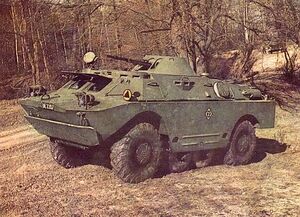Calinthian People's Army: Difference between revisions
mNo edit summary |
mNo edit summary Tag: 2017 source edit |
||
| Line 123: | Line 123: | ||
|Mostly BT-51s, and BT-62s | |Mostly BT-51s, and BT-62s | ||
|} | |} | ||
<br> | |||
==Gallery== | |||
<gallery class="center" widths="190" heights="160" caption="BSG-3"> | |||
</gallery> | |||
==Notes== | ==Notes== | ||
Calinthian People's Army had direct control over the Air Force wing of the Calinthian People's Military. | Calinthian People's Army had direct control over the Air Force wing of the Calinthian People's Military. | ||
Revision as of 23:37, 27 April 2023
| Calinthian People's Army Gothic: Kalinthische Volksarmee | |
|---|---|
| Motto | Für Gott und die Einheit der Arbeiter (For God and Unity of the Workers) |
| Founded | Founded in 1942. |
| Current form | Military Besserung of 1944 |
| Disbanded | 1989. |
| Headquarters | Spesnova, Calinthia |
| Leadership | |
| Grand General | Siegmund Goering |
| Minister of Defense | General of the Military Friedrich von Guder |
| Manpower | |
| Military age | 18 |
| Conscription | Yes, mandatory for males and females. |
| Active personnel | 1,263,138 military & 219,114 civilian (1978) |
| Reserve personnel | At any time, 2,000,000 reservists could be called upon |
| Industry | |
| Domestic suppliers | Bralonia • |
| Foreign suppliers | |
| Related articles | |
| History | Military history of Calinthia |
| Ranks | Ranks and insignia of the Calinthian People's Army |
The Calinthian People's Army (KVA) was the military of the Communist State of Calinthia. Gothic: "Kommunistischer Staat Kalinthische"
History
The history of the Calinthian People's Army dates back to the creation of the Communist State of Calinthia (CSC) in 1942. The Calinthian People's Army was raised to defend the goals of the Calinthian Communist Party in establishing a Soviet State during the Calinthian Civil War. The Calinthian Civil War would rage for six years and would see the KVA fight against Republican Guard Forces and Loyalist Forces.

The Communist uprisings on the Western territories of Calinthia by mainly Gothic Calinthians resulted in Republican Guard Forces being stretched thin. At first the Communist Calinthians and Loyalist Calinthians would openly fight one another in many minor skirmishes in the North. However, by late 1937 the Communist Calinthians under General Secretary of the Communist Party Siegmund Goering (1901 - 1991) would ally themselves with the Loyalists against the Republican Guard Forces. With Communist forces in the West and Loyalists in the East, the Republican Guard quickly found themselves on the back-foot. By early 1940, Republican Guard Forces prepared a hastily built defense around Aurelia and struggled to maintain their supply lines from the port of Napolis. Constant air attacks by the superior Loyalist air force rendered many of the railroads inoperable. In addition, the mechanized Communist assaults using a tactic called "Schwerpunkt" penetrated deep into Republican Guard lines, cutting supply lines. The tactic was an adaptation of the Urcean "lightning war" tactic developed by Benno de Caryale. It was adapted and implemented by the Calinthian People's Army under the command of General Friedrich von Guder (1910 - 1994) a graduate of the Urcean Imperial War College and student of de Caryale's tactics.



The Calinthian Civil War resulted in the dissolution of the Republic of Calinthia and it's military in 1942. Following the collapse of the Republic of Calinthia, Gothic Calinthians formalized their new state through the creation of the Communist State of Calinthia.
Command structure
Organization
Tactics & Strategy

Since the Military Besserung of 1944, Calinthian ground tactics consisted of large mechanized and armored assaults. This tactic is also known as "Schwerpunkt" and was adapted by Friedrich von Guder. It relies on overwhelming armored force concentrated on as small of a section of the battlefield as possible. The KVA used the tactics to great effect both in the Calinthian Civil War against the Republican Guard and in the War of Hearts against the Loyalist forces.
Equipment
All numbers are approximate and as per the Calinthian People's Army own statistics at the time of the collapse of the Communist State of Calinthia in 1989.
| Equipment | Numbers | Notes |
|---|---|---|
| Main Battle Tanks | 6,121 | |
| APCs/IFVs/Scout Cars | 11,613 | Mostly BM-52s, BM-62s, and BT-51s. |
| Utility Vehicles | 3,111 | |
| Trucks | 612 | |
| Towed Artillery | 14,689 | |
| MLRS | 912 | |
| Fighter Aircraft | 114 | Land deployment only |
| Bomber Aircraft | 346 | Land deployment only |
| Transport Helicopters | 189 | Most are AMS-68 imported from Yonderre |
| Attack Helicopters | 123 | Most are AMS-72 imported from Yonderre |
| Amphibious Assault Vehicles | 4,896 | Mostly BT-51s, and BT-62s |
Gallery
- BSG-3
Notes
Calinthian People's Army had direct control over the Air Force wing of the Calinthian People's Military.